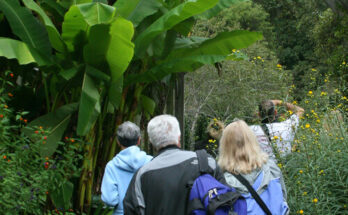Chrysanthemum × koreanum (kris-AN-the-mum kor-ee-AH-num) are perennial plants that can be easily grown in the landscape, even in frigid climates.
These members of the Asteraceae family of plants grow wild in many parts of the world, including Indo-China, Eurasia, Canada, the United States, and subArctic America.

You may hear this hardy wild or naturalized flower referred to as:
- Hardy Chrysanthemum
- Hardy Garden Mum
- Old-Fashioned Mum
- Chrysanthemum
- Heritage Mum
- Mums
Chrysanthemum is a word derived from ancient Greek. It means “gold flower.” The specific epithet, koreanum (or coreanum) means from Korea. All mums come from the composite flower family.
Some of the popular varieties of chrysanthemum include:
- ‘Allouise Pink’
- ‘Anastasia Green’
- ‘Fireglow Bronze’
- ‘Hillside Sheffield Pink’
- ‘Moonbeam’
Hardy Chrysanthemum Plant Care
Hardy Chrysanthemums are known to be low-maintenance and hardy plants, making them an excellent choice for your garden.
Size and Growth
Hardy Mums have a rounded growth habit. Mounds grow to be 2′ or 3′ feet tall with an equal width.
The plants’ simple green leaves grow in an alternating arrangement. They are smooth, lobed, and slightly fragrant when crushed.
Leaves are typically between 3” and 6” inches in length. Mature leaves found at the base of the plant are longer than newer leaves found at the top.
Related: Caring For Leucanthemum Maximum – Shasta Daisy
Flowering and Fragrance
Hardy Garden Mums’ daisy-like flowers are showy and abundant. They bloom in the late summer and fall in various colors, including white, cream, yellow, gold, pink, red, burgundy, lavender, and purple. Depending on the variety, some mums may also have yellow centers.
Plants bloom throughout the summer and into autumn. The chrysanthemum flowers are barely scented and attractive to bees, butterflies, and other pollinators.
Light and Temperature
These hardy wildflowers like bright, full sun exposure. They need at least 6 to 8 hours of direct sunlight daily.
All-day dappled sun is also acceptable. However, in partial shade, they tend to get leggy and unwieldy.
Heritage Mums are winter hardy in USDA hardiness zones 4a-8b.
Watering and Feeding
Once established, these wildflowers will probably do very well with only natural rainfall. In times of extreme drought, water deeply, occasionally at ground level.
Remember to give your mums an inch of water per week after they’re established.
No fertilizer is necessary. However, feeding with liquid fertilizer in late spring is recommended for container-grown plants.
Moreover, keeping the soil around the plants well-mulched with an organic matter should provide ample nutrients while helping retain moisture in the soil.
Soil and Transplanting
Mums thrive in light, airy, fertile, well-draining soil rich in organic matter. However, they can tolerate a wide range of soil types.
Add compost or other organic materials to your organic soil if you want a healthy plant.
Moreover, it is best to transplant Hardy Mums in the springtime so they will have plenty of time to establish themselves before the cold months of autumn and winter.
If you must transplant them in the fall, prune off all blooms and excess foliage. This will encourage root growth. Apply a thick layer of organic mulch to protect the new roots during the cold weather.
Moreover, remember that it’s best to plant mums in a sunny spot, especially if you plan on growing them outdoors.
Hardy Chrysanthemums: Grooming and Maintenance
When buds appear in the spring, prune your plants vigorously (or even mow them!) This will encourage more branching compact growth and more abundant blooms.
Pinching your mums also helps promote bushy plants, increases blooms and buds, and delays bloom time.
You can prune or mow again if your chrysanthemum plants get leggy during the summer. If you mow, set your blades high enough to leave several inches of stems. You don’t want to cut all the way down to the plant’s crown.
Moreover, you can clip faded flowers on your established mums after a killing frost.
You can also overwinter your potted plants by moving them to a sheltered location or a cold frame. Putting down a good layer of mulch will also provide extra winter protection to prevent the risks of frost.
How To Propagate Hardy Chrysanthemums
You can propagate Heritage Mums from stem cuttings in early summer or late spring.
It is also possible to propagate them through division. It’s a good idea to divide them from the parent plant once every two or three years to prevent overcrowding and dieback. Do this in the springtime.
If you want to propagate mums from seed, it’s best to collect them from the dried heads of spent chrysanthemum flowers or buy them from garden centers. However, growing mums from seed are no easy task, as germinating can take longer.
Hardy Chrysanthemums Main Pest or Diseases
For the most part, Old-Fashioned Mum is trouble-free. However, this plant may be prone to a variety of diseases, including:
The best way to prevent the spread of disease is to remove the diseased plants and destroy the entire plant immediately.
It’s also important to avoid water overhead because water on the leaves can cause mold and mildew problems. In addition, keep the soil moist enough but not too soggy to avoid leaf wilting.
Spraying anti-fungal sprays will also remedy this problem.
Moreover, leaf miners, spider mites, and aphids may occasionally cause some foliage damage.
Is the Chrysanthemum Considered Toxic or Poisonous to People, Kids, and Pets?
The fragrant leaves of Garden Mum contain an oil that can cause severe skin irritation. Be sure to wash up after working with or handling these plants.
Additionally, ingesting the leaves and flowers can cause gastric distress, diarrhea, vomiting, and excessive salivation. Keep kids and pets away.
Observe livestock closely if Mums are growing in your pasture. Mostly, horses and cattle do not tend to like these flowers. The blooms and leaves are unlikely to harmless discerning livestock, such as goats.
Is The Chrysanthemum Considered Invasive?
Chrysanthemum × koreanum is not invasive. There are a few look-alike imposters who are, though. Among them is Mugwort, which is sometimes called Wild Chrysanthemum. This is actually an invasive Artemisia.
Another is Ox-eye Daisy (Chrysanthemum leucanthemum) which grows abundantly throughout the United States and is considered a noxious weed in several states.
Suggested Hardy Chrysanthemums Uses
These very easy-to-grow Mums are an excellent choice for almost any garden setting. They will produce attractive lush blooms in late summer.
They will also do well in mass plantings, small groupings, along borders, in containers, pollinator gardens, cottage gardens, rock gardens, and more.
They will also provide your mixed borders or autumn garden with a pop of color.
In addition, planting single varieties also helps provide nectar for pollinators, including bees and butterflies. They also make beautiful and long-lasting cut flowers.
Source link
Originally posted 2023-03-25 16:06:49.




